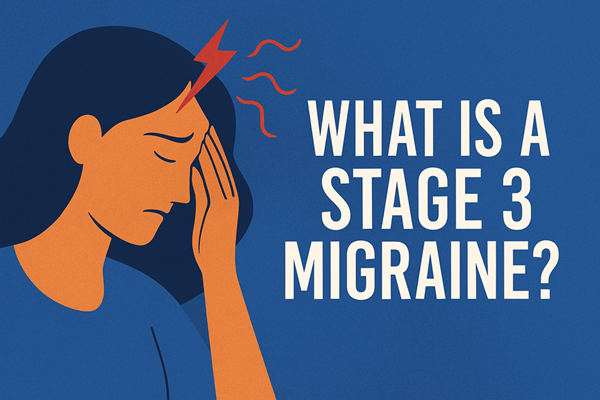What Is a Stage 3 Migraine?

Migraines are more than just bad headaches; they’re complex neurological events that can severely impact daily life. Many people don’t realise that migraines can develop in distinct stages, each with its own symptoms. Understanding these stages is key to recognising the early warning signs and managing the condition effectively.
In this post, we’ll explore what Stage 3 of a migraine is, how it fits into the migraine cycle, and how alternative treatments, such as medical cannabis, can offer relief when conventional options fall short.
The four stages of a migraine
Not everyone experiences every stage of a migraine, but many sufferers report a predictable pattern:
- Prodrome (stage 1): Occurs hours or even days before the headache. Symptoms may include fatigue, mood changes, food cravings, neck stiffness, or difficulty concentrating.
- Aura (stage 2): Experienced by around a third of migraine sufferers, aura can include visual disturbances (flashing lights, blind spots), tingling in the limbs, or difficulty speaking.
- Headache (stage 3): This is the stage most people associate with migraines.
- Postdrome (stage 4): After the headache subsides, some people feel drained, confused, or mentally foggy for up to 24 hours.
What happens during stage 3 of a migraine?
Stage 3 is the headache phase, and it’s often the most intense and debilitating part of a migraine attack. It can last anywhere from 4 to 72 hours if left untreated.
Common symptoms during this stage include:
- Throbbing or pulsing head pain, usually on one side
- Sensitivity to light, sound, or smells
- Nausea or vomiting
- Dizziness or blurred vision
- Worsening pain with movement or physical activity
The severity varies from person to person, but for many, it can be completely disabling, forcing them to retreat to a dark, quiet room until the episode passes.
What triggers stage 3?
By the time Stage 3 sets in, the migraine process is in full swing. It can be triggered by:
- Hormonal changes (especially in women)
- Stress or emotional strain
- Certain foods and drinks (like chocolate, cheese, red wine, or caffeine)
- Sleep disruption
- Bright lights or strong smells
- Weather changes
Identifying and managing these triggers can help reduce the frequency of attacks.
How can a cannabis prescription help?
For those who suffer from frequent or treatment-resistant migraines, standard medications like triptans or painkillers may not always be effective, or they may come with unpleasant side effects.
This is where medical cannabis is becoming increasingly recognised as an option in the UK for certain patients.
Studies suggest that cannabis may help reduce the intensity, duration, and frequency of migraine attacks. It does so by interacting with the body’s endocannabinoid system, which plays a role in regulating pain, inflammation, and neurological function.
Potential benefits of a cannabis prescription for migraine sufferers include:
- Pain relief during Stage 3
- Reduced nausea and vomiting
- Improved sleep during and after attacks
- Decreased frequency of migraines over time
- Fewer side effects compared to some traditional medications
While it’s not a one-size-fits-all solution, for many people living with chronic migraines, prescribed medical cannabis offers a promising alternative when other treatments have failed.
Final thoughts
Stage 3 of a migraine is where the pain peaks and symptoms become most disruptive. Recognising this stage and knowing your options can help you take control of the situation.
If you’re struggling with frequent or severe migraines that haven’t responded well to traditional treatments, it may be time to consider a cannabis prescription. With proper guidance and medical supervision, it could offer you the relief you’ve been searching for.


